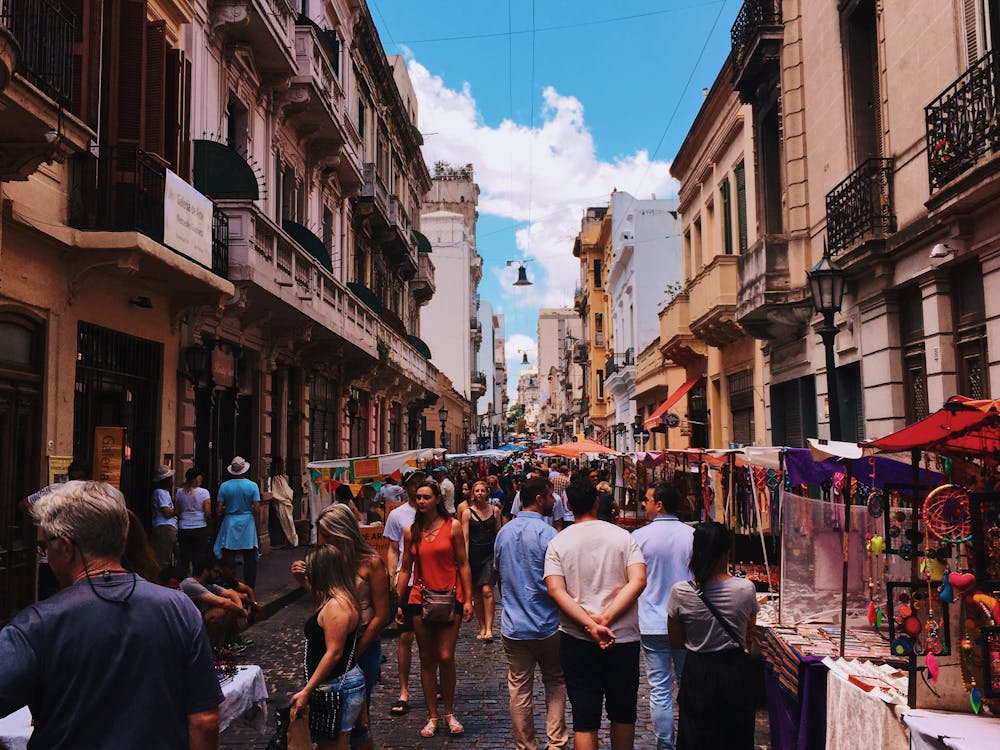What are some of the interesting facts about Argentina? Argentina, the eighth-largest country in the world and the second-largest in South America boasts a rich tapestry of culture, history, and natural wonders. Nestled between the Andes Mountains and the South Atlantic Ocean, this diverse nation is renowned for its vibrant cities, stunning landscapes, and passionate people. Buenos Aires, the capital, is a bustling metropolis famed for its European architecture, tango dancing, and culinary delights. Beyond the urban sprawl, Argentina’s vast and varied geography encompasses everything from the otherworldly landscapes of Patagonia to the lush wine regions of Mendoza. In this article, I will talk about some interesting facts about Argentina.
Interesting Facts About Argentina: History, Culture, Travel
The country’s cultural heritage reflects a blend of indigenous traditions, Spanish colonial influence, and waves of immigration from around the globe. Argentina is also synonymous with soccer, with a fervent fan base and a rich history of producing some of the world’s greatest players. From the majestic Iguazu Falls in the north to the rugged beauty of Tierra del Fuego in the south, Argentina offers travelers a captivating journey through a land of contrasts and enchantment. Here are some interesting facts about Argentina:
1. The Land of the Disappeared
Within the annals of Argentina’s history lies a haunting chapter known as the “Dirty War,” a period of state-sponsored terror and repression that cast a shadow over the nation from 1976 to 1983. Under the iron grip of a military dictatorship, thousands of people vanished without a trace, abducted from their homes, workplaces, and streets by government forces. These “disappeared” were subjected to torture, imprisonment, and often execution, their fates shrouded in secrecy and silence.
Yet, despite the regime’s attempts to erase their existence, the memory of the disappeared lives on in the hearts and minds of their loved ones and the collective consciousness of the nation. The struggle for human rights and remembrance remains a poignant and significant aspect of Argentina’s identity, a testament to the enduring spirit of resilience and resistance that defines its people.
2. The Land of Innovation
Amidst the shadows of its tumultuous past, Argentina emerges as a beacon of innovation and ingenuity, with a proud legacy of scientific and technological achievement that spans a myriad of fields. From groundbreaking discoveries in medicine and agriculture to pioneering advancements in aerospace and beyond, Argentina’s contributions to the world of science and technology are as diverse as they are impactful. With world-class research institutions, dedicated scientists, and a spirit of innovation that knows no bounds, the nation continues to push the boundaries of knowledge and exploration, inspiring future generations to dream, discover, and create.
3. A Future Filled with Potential
Despite the economic challenges that have plagued Argentina in recent years, the nation remains a vibrant tapestry of culture, creativity, and possibility. From the bustling streets of Buenos Aires to the windswept plains of Patagonia, Argentina captivates the imagination with its passionate people, rich history, and breathtaking landscapes. Though the road ahead may be fraught with obstacles, the spirit of resilience and determination that courses through the veins of its citizens offers hope for a brighter tomorrow. As Argentina navigates the currents of change and transformation, it stands poised on the precipice of a future filled with potential, where the echoes of the past mingle with the promise of what is yet to come.
4. The Land of the Gaucho Cross (Cruz Gaucha)
Embedded within the cultural fabric of Argentina lies a symbol of profound significance: the Gaucho Cross, or Cruz Gaucha. Simple yet laden with meaning, this cross, often fashioned from humble materials such as wood or iron, serves as a tangible expression of the gaucho’s faith and connection to the boundless expanse of the pampas. For the gaucho, a figure synonymous with the rugged spirit of the Argentine countryside, the cross embodies a deep sense of spirituality and reverence for the land. Whether adorning the walls of humble dwellings or standing sentinel amidst the vast plains, the Gaucho Cross serves as a timeless reminder of the enduring bond between humanity and nature, a testament to the resilience, and resourcefulness of Argentina’s rural communities.
5. Traditional Music Beyond Tango
Beyond the sultry embrace of tango, Argentina’s musical landscape unfolds in a rich tapestry of diverse styles and influences, each reflecting the nation’s vibrant cultural mosaic. From the pulsating rhythms of chamamé, a folk music tradition hailing from the northeastern provinces, to the haunting melodies of folklore music, which draws upon indigenous and European traditions, Argentina’s musical heritage is as varied as it is vibrant.
In the rustic villages of the countryside and the bustling neighborhoods of the cities, the strains of traditional music fill the air, inviting listeners on a journey through the soul of the nation. With its evocative melodies and intricate rhythms, traditional Argentine music serves as a powerful expression of identity and belonging, weaving together threads of history, heritage, and collective memory into a tapestry of sound that resonates with audiences both at home and abroad.
6. Tango Takes Center Stage
In the sultry embrace of Tango, an art form born in Argentina’s vibrant neighborhoods resides a rich tapestry of emotions and cultural heritage. This dance, with its origins tracing back to the 19th century, symbolizes not just movement but a profound expression of passion and intensity. Originating from the marginalized communities of Buenos Aires, Tango has evolved into a national treasure, captivating hearts worldwide with its intricate steps and emotive storytelling through movement.
Tango’s allure lies in its ability to weave a narrative of desire, longing, and melancholy, all within the fluid motions of its dancers. Each step is a testament to the history of Argentina, reflecting the struggles, triumphs, and resilience of its people. From the smoky milongas of the past to the grand stages of international dance festivals, Tango has transcended its humble beginnings to become a cultural ambassador for Argentina. Its seductive rhythms and graceful choreography continue to enchant audiences, preserving a piece of Argentine identity for generations to come.
7. Land of Extremes
Argentina, a nation of breathtaking diversity, unfolds like a canvas painted with contrasting landscapes and natural wonders. To the west, the mighty Andes Mountains stand tall, their snow-capped peaks piercing the sky in a display of awe-inspiring grandeur. Stretching endlessly to the east are the boundless Pampas, vast plains where the heartbeat of Argentina’s agricultural prowess echoes through fields of golden wheat and grazing cattle.
Venture further into the heart of the country, and you’ll find yourself immersed in the lush vineyards of Mendoza, where the fertile soil gives birth to some of the world’s finest wines. But the true marvel lies in the south, where the icy embrace of Patagonia’s glaciers beckons adventurers and nature enthusiasts alike. Here, jagged peaks and turquoise lakes paint a surreal landscape, offering a glimpse into the raw, untamed beauty of the southernmost reaches of the continent.
From the arid deserts of the north to the pristine wilderness of the south, Argentina’s landscapes are as diverse as they are captivating, inviting travelers to embark on a journey of discovery through nature’s most spectacular creations.
8. Home to the Highest Peak in the Americas
Standing sentinel over the Andes, Aconcagua reigns supreme as the highest peak in the Americas, a towering monument to the indomitable spirit of exploration and adventure. Rising to an awe-inspiring height of 6,962 meters (22,841 ft), this majestic mountain beckons climbers from across the globe to test their mettle against its formidable slopes.
For centuries, Aconcagua has captured the imagination of adventurers, its sheer magnitude serving as both a challenge and an irresistible allure. Each year, brave souls embark on the arduous journey to its summit, braving frigid temperatures, treacherous terrain, and unpredictable weather in pursuit of glory and personal triumph.
But Aconcagua is more than just a mountain; it is a symbol of human resilience and determination, a testament to the unyielding spirit of exploration that drives us to push beyond our limits in search of the extraordinary. As climbers ascend their slopes, they carry with them the dreams of generations past, forging a connection between the present and the storied history of this legendary peak.
9. First Lady of Presidents
Argentina holds a distinguished place in the annals of political history, particularly regarding the pivotal role women have played in shaping its destiny. A landmark moment occurred in 1974 when Isabel Perón ascended to the presidency, marking not only a significant milestone for Argentina but for the world at large. As the first woman to hold the highest office in a presidential system, Isabel Perón’s inauguration represented a triumph of gender equality and shattered centuries-old glass ceilings.
Her tenure, though tumultuous, showcased the resilience and capabilities of female leadership on the global stage, leaving an indelible mark on the collective consciousness of a nation and inspiring generations of women to follow in her footsteps.
10. Gaucho Culture
In the sprawling expanse of Argentina’s Pampas, the spirit of the gaucho, a figure steeped in myth and legend, reigns supreme. These rugged horsemen, masters of the saddle and the lasso, embody the essence of Argentina’s rural heritage, serving as guardians of tradition in a rapidly changing world. Their tales of bravery and adventure have been immortalized in literature and folklore, painting a vivid portrait of a bygone era where honor, loyalty, and courage were the currency of the land.
From the thundering hooves of their steeds to the rhythmic twirl of their boleadoras, the gauchos command respect and admiration, their presence an enduring symbol of Argentina’s frontier spirit and indomitable resilience.
11. Mate: A National Habit
In the social fabric of Argentina, there exists a ritual as cherished and revered as any ancient tradition: the sharing of mates. This caffeinated herbal infusion, brewed from the leaves of the yerba mate plant, is more than just a beverage; it is a cultural phenomenon deeply ingrained in the collective consciousness of the nation. Passed from hand to hand, sipped from a gourd with a metal straw known as a bombilla, mate transcends mere sustenance to become a symbol of friendship, camaraderie, and hospitality.
Whether shared among friends gathered in a circle or offered as a gesture of goodwill to strangers, the act of drinking mate fosters connections and strengthens bonds, weaving a tapestry of unity that binds Argentina’s diverse population together. In every sip lies the essence of Argentine identity, a testament to the enduring power of tradition in an ever-changing world.
12. Football (Soccer) Fanatics
In the vibrant tapestry of Argentine culture, one thread stands out above all others: football, the beautiful game that reigns supreme in the hearts and minds of its people. With a fervor bordering on religious devotion, Argentina embraces football as more than just a sport but as a way of life. At the center of this passion lies the national team, a powerhouse of talent and determination that has etched its name in the annals of sporting history.
With two FIFA World Cup victories to their name, in 1978 and 1986, the Albiceleste commands reverence and respect on the global stage, their iconic blue and white stripes a symbol of pride and unity for millions of fans across the nation. From the bustling streets of Buenos Aires to the remote villages of the Andean foothills, the roar of the crowd reverberates with every goal scored, and every victory celebrated, weaving a tapestry of joy and camaraderie that transcends borders and unites a nation in a shared passion for the beautiful game.
13. Land of the Tango Masters
In the sultry embrace of Tango, Argentina finds not just a dance but a cultural phenomenon that has captivated the world’s imagination. At its heart beats the rhythm of legends like Carlos Gardel and Astor Piazzolla, whose mastery of music and movement propelled Tango onto the global stage. Born in the smoky milongas of Buenos Aires, Tango is more than just a dance; it is an expression of longing, desire, and melancholy, woven together in a sensual tapestry of movement and music.
Through the haunting melodies of the bandoneón and the graceful steps of its dancers, Tango tells the story of Argentina, a nation steeped in passion and tradition. From the dimly lit clubs of the Argentine capital to the grand stages of Paris and New York, the legacy of Tango endures, a testament to the enduring power of Argentine culture to captivate and inspire.
14. The Southernmost City in the World:
Nestled at the edge of the Earth, where the rugged landscape of Patagonia meets the icy waters of the Southern Ocean, lies Ushuaia, the crown jewel of Argentina’s southernmost reaches. Known affectionately as “The End of the World,” this remote city offers a gateway to adventure unlike any other. Surrounded by towering mountains and pristine wilderness, Ushuaia beckons travelers to explore its untamed beauty and embrace the spirit of exploration that defines the region.
Whether trekking through the snow-capped peaks of Tierra del Fuego National Park or sailing through the icy waters of the Beagle Channel, visitors to Ushuaia are rewarded with breathtaking vistas and unforgettable experiences at the edge of the known world. And yet, despite its remote location, Ushuaia pulses with life and energy, its vibrant culture and warm hospitality welcoming travelers from across the globe to discover the magic of Argentina’s southernmost city.

15. The Perito Moreno Glacier
In the heart of Patagonia, where the windswept plains meet the towering peaks of the Andes, lies a frozen marvel that defies imagination: the Perito Moreno Glacier. This ancient behemoth of ice, one of the few glaciers in the world still advancing, stands as a testament to the raw power and beauty of nature. Its shimmering blue hues and jagged crevasses form a landscape straight out of a dream, captivating all who lay eyes upon it.
But it is not just its majestic appearance that draws visitors from far and wide; it is the dynamic spectacle of its movement, the thunderous roar of calving ice echoing across the pristine wilderness. Each rupture, each crash, is a reminder of the delicate balance of our planet, a fleeting glimpse into the inexorable march of time. To stand in the presence of the Perito Moreno Glacier is to bear witness to nature’s grandeur in its purest form, a humbling experience that leaves an indelible mark on the soul.
16. Wine Wonderland
In the sun-kissed vineyards of Mendoza, Argentina’s wine industry flourishes, producing some of the world’s most sought-after varietals. At the heart of this oenological paradise lies the Malbec grape, a bold and robust variety that has become synonymous with Argentine wine. Here, amid the backdrop of the snow-capped Andes, rows upon rows of vines stretch as far as the eye can see, their lush greenery yielding grapes of unparalleled quality and flavor.
From the elegant reds of Malbec to the crisp whites of Torrontés, Argentina’s winemakers craft a symphony of flavors that tantalize the palate and delight the senses. But it is not just the wine itself that captivates; it is the experience of sipping a glass amid the serene beauty of the vineyards, the sun setting over the horizon as laughter and conversation fill the air. In Mendoza, wine isn’t just a beverage; it is a way of life, a celebration of the land and its bountiful harvests, and a toast to the good fortune of those fortunate enough to partake.
17. Land of the Dinosaurs
Beneath the sun-baked earth of Argentina’s arid plains lies a treasure trove of prehistoric wonders, a testament to the country’s rich geological history. Here, among the rugged landscapes of Patagonia, paleontologists have unearthed fossil remains of creatures long extinct, including some of the largest and most awe-inspiring dinosaurs to ever roam the Earth. Chief among these is the Argentinosaurus, a colossal behemoth that once lumbered across the ancient landscape, its sheer size dwarfing all other land creatures of its time.
But the Argentinosaurus is just one of many remarkable discoveries made in Argentina, where fossilized bones and imprints offer a glimpse into a lost world teeming with life. From the ferocious Tyrannosaurus rex to the graceful Triceratops, the fossils of Patagonia paint a vivid picture of a bygone era, igniting the imaginations of scientists and enthusiasts alike and reaffirming Argentina’s status as a land of wonder and discovery.
18. The Colorful La Boca
Nestled along the bustling waterfront of Buenos Aires lies a neighborhood bursting with color and vitality: La Boca. Renowned for its kaleidoscope of brightly painted houses, adorned with splashes of vibrant hues that dance in the sunlight, La Boca is a feast for the senses. But it’s not just the colorful facades that draw visitors from far and wide; it’s the lively energy that pulses through its streets, the rhythmic beat of tango music echoing from every corner. Here, amid the cobblestone alleyways and bustling markets, street artists ply their trade, their vibrant murals telling stories of passion, struggle, and triumph.
And at the heart of it all is the tango, the soulful dance that embodies the spirit of Argentina, performed with gusto in the milongas and clubs that line the neighborhood’s streets. To wander through La Boca is to immerse oneself in a whirlwind of sights, sounds, and sensations, a vibrant tapestry of culture and creativity that captures the essence of Buenos Aires’s bohemian spirit.
19. Buenos Aires: The Paris of South America
At once grand and graceful, Buenos Aires stands as a beacon of elegance and sophistication in the heart of South America, earning its moniker as the “Paris of the South.” From the majestic boulevards of Avenida de Mayo to the ornate facades of Recoleta’s historic mansions, the city’s architecture bears witness to a bygone era of opulence and refinement. But it’s not just the grandeur of its buildings that sets Buenos Aires apart; it’s the vibrant energy that pulsates through its streets, the eclectic mix of cultures and influences that infuse every corner with life.
Here, amidst the bustling cafes and bustling plazas, artists and intellectuals gather to debate and discourse, their voices rising above the cacophony of the city in a symphony of ideas and inspiration. From the sultry strains of a tango orchestra to the lively chatter of a sidewalk cafe, Buenos Aires captivates the senses and stirs the soul, inviting visitors to lose themselves in its enchanting embrace.
20. Land of Literature
In the hallowed halls of Argentine literature, words become art, and stories transcend time and space to captivate readers around the globe. At the forefront of this literary renaissance stand giants like Jorge Luis Borges and Julio Cortázar, whose words weave a tapestry of imagination and insight that continues to resonate with readers to this day. From the labyrinthine mysteries of Borges’s “Labyrinths” to the surreal landscapes of Cortázar’s “Hopscotch,” Argentine literature offers a journey into the depths of the human experience, exploring themes of identity, memory, and the nature of reality itself.
But it’s not just the Nobel laureates who have left their mark on Argentina’s literary landscape; it’s the countless poets, novelists, and storytellers whose voices echo through the pages of history, enriching the cultural tapestry of the nation with their words. In Argentina, literature isn’t just a pastime; it’s a passion, a legacy passed down from generation to generation, a testament to the enduring power of storytelling to illuminate the human condition.
21. The Falkland Islands Dispute
Amidst the windswept seas of the South Atlantic lies a contentious issue that has simmered for centuries: the Falkland Islands dispute. Known as the Islas Malvinas in Argentina, these remote islands have been at the center of a long-standing territorial dispute between Argentina and the United Kingdom. For Argentina, the islands represent an integral part of its national identity, a symbol of sovereignty and historical legacy.
Yet for the United Kingdom, they stand as a testament to its colonial past and the rights of self-determination of the islanders. The dispute, rooted in centuries of geopolitical maneuvering and colonial history, remains unresolved, casting a shadow over diplomatic relations between the two nations and fueling tensions in the region. Despite efforts to find a peaceful resolution, the Falkland Islands dispute continues to be a flashpoint in South American politics, a reminder of the complex legacy of colonialism and the enduring quest for sovereignty and self-determination.
22. The Iguazu Falls: A Natural Wonder
Nature’s grandeur unfolds spectacularly at the awe-inspiring Iguazu Falls, a breathtaking cascade of water that straddles the border between Argentina and Brazil. Designated as a UNESCO World Heritage Site, these magnificent falls are a testament to the power and beauty of the natural world. Here, amidst the lush rainforest of the surrounding national parks, visitors are treated to a sensory feast of sights and sounds as the mighty waters of the Iguazu River plunge over precipitous cliffs, creating a symphony of mist and rainbows.
From the thundering roar of Devil’s Throat to the serene beauty of San Martín Island, each vista offers a glimpse into the sublime majesty of one of the world’s most iconic natural wonders. For any visitor to Argentina, a journey to the Iguazu Falls is not just a sightseeing excursion; it is a pilgrimage to the heart of the earth’s primal forces, a humbling reminder of our place in the tapestry of creation.
23. The Gaucho Code
In the vast expanse of Argentina’s Pampas, where the sky meets the horizon in an unbroken line, the spirit of the gaucho lives on in the “código gaucho,” an unwritten code of honor that defines the ethos of the Argentine countryside. Rooted in centuries of tradition and folklore, this code emphasizes values such as hospitality, courage, and loyalty, shaping the character of those who call the Pampas home.
For the gaucho, hospitality is not just a custom but a sacred duty, a testament to the generosity of spirit that defines Argentine culture. Likewise, courage is a hallmark of the gaucho ethos, embodied in the fearless spirit of those who ride the open plains in pursuit of adventure and freedom. Above all, loyalty is the bedrock upon which the gaucho code is built, binding together communities and forging bonds that endure through hardship and triumph alike. In the modern world, the código gaucho remains a potent cultural influence, a reminder of the enduring values that define the Argentine spirit and shape its national identity.
24. Asado Delights
Step into the heart of Argentine culinary tradition with the irresistible allure of asado, a time-honored ritual that transcends mere dining to become a celebration of flavor, family, and friendship. At the center of this culinary extravaganza is the parrilla, a grill where succulent cuts of beef, chorizo sausages, and offal-like sweetbreads sizzle and smoke to perfection. Each bite is a symphony of smoky richness, the result of hours of slow cooking over glowing embers, imparting a depth of flavor that tantalizes the taste buds and leaves diners craving more.
But asado is more than just a meal; it’s a social event, a gathering of loved ones where laughter flows as freely as the wine and conversations linger long into the night. From the sprawling estancias of the countryside to the bustling streets of Buenos Aires, the aroma of asado beckons, inviting all who encounter it to partake in the timeless tradition of Argentine barbecue.
25. Empanadas for Every Occasion
Indulge in the culinary delights of Argentina with the versatile and irresistible empanada, a savory pastry that delights the senses and satisfies the soul. Whether filled with succulent beef, gooey cheese, or vibrant vegetables, these hand-held treasures are a staple of Argentine cuisine, enjoyed at any time of day and for any occasion. From the bustling streets of Buenos Aires to the remote corners of the countryside, empanadas are a ubiquitous presence, their golden crusts and flavorful fillings drawing hungry crowds wherever they go.
But it’s not just their delicious taste that makes empanadas so beloved; it’s their versatility, their ability to adapt to any palate and preference, whether served as a quick snack on the go or as the star attraction at a festive gathering. With each bite, empanadas offer a taste of Argentina’s culinary heritage, a delicious reminder of the country’s rich and diverse gastronomic traditions.
26. The Dulce de Leche Craze
Satisfy your sweet tooth with the irresistible allure of dulce de leche, a creamy caramel sauce that has captured the hearts and palates of Argentines for generations. Whether drizzled over pancakes, spread on toast, or swirled into ice cream, dulce de leche is a beloved ingredient in Argentina, cherished for its rich, indulgent flavor and velvety smooth texture. But its appeal extends far beyond its use in desserts; dulce de leche is a cultural icon, a symbol of Argentine ingenuity and culinary prowess.
From the bustling cafés of Buenos Aires to the cozy kitchens of rural estancias, the aroma of simmering milk and sugar fills the air, signaling the creation of this beloved treat. With each spoonful, dulce de leche offers a taste of nostalgia, a reminder of childhood memories and cherished moments shared with loved ones. In Argentina, the dulce de leche craze shows no signs of slowing down, its delicious allure continuing to captivate hearts and palates alike.
27. The Teatro Colón: A Stage for Excellence
Step into the hallowed halls of the Teatro Colón, an architectural masterpiece and cultural gem nestled in the heart of Buenos Aires. Renowned as one of the finest opera houses in the world, the Teatro Colón stands as a testament to Argentina’s passion for the performing arts and commitment to excellence. From its opulent interiors adorned with gilded décor to its impeccable acoustics that rival the finest concert halls of Europe, every aspect of the Teatro Colón exudes grandeur and sophistication.
But it’s not just the physical beauty of the theater that captivates audiences; it’s the caliber of performances that grace its stage. From breathtaking operas to dazzling ballets, the Teatro Colón plays host to the world’s most prestigious artists, enchanting audiences with their talent and artistry. For lovers of culture and refinement, a visit to the Teatro Colón is an unforgettable experience, a journey into the realm of high art and timeless beauty that leaves an indelible mark on the soul.
28. National Parks Paradise
Embark on an adventure into the heart of Argentina’s natural wonders with a visit to its breathtaking national parks, where rugged landscapes and pristine wilderness await. From the towering peaks of the Andes to the lush forests of the Amazon, Argentina’s national parks offer a sanctuary for wildlife and a playground for outdoor enthusiasts. Here, amidst the untamed beauty of nature, visitors can hike through ancient forests, trek to remote mountain vistas, and witness awe-inspiring waterfalls that defy imagination. How AI, ChatGPT maximizes earnings of many people in minutes
But it’s not just the stunning scenery that draws travelers from far and wide; it’s the sense of awe and wonder that permeates every corner of these protected areas, a reminder of the importance of conservation and stewardship in preserving our planet’s natural heritage. Whether exploring the otherworldly landscapes of Patagonia or immersing oneself in the rich biodiversity of the Iguazu National Park, a journey through Argentina’s national parks is a journey into the heart of paradise.
29. Whale Watching Wonders
Experience the majesty of the ocean’s giants with a thrilling whale-watching adventure along Argentina’s picturesque coastlines, where the waters teem with life and wonder. In the pristine waters of Patagonia, particularly around the Valdes Peninsula, visitors have the opportunity to witness the awe-inspiring spectacle of humpback whales and southern right whales as they migrate along the coast. From the vantage point of a boat or the rugged cliffs overlooking the sea, travelers can marvel at these magnificent creatures as they breach, spout, and play in the waves, their immense size and graceful movements a testament to the beauty and power of the natural world.
But it’s not just whales that grace Argentina’s coastal waters; dolphins, seals, and sea lions also call these seas home, adding to the richness and diversity of marine life that thrives in these pristine habitats. For nature lovers and adventure seekers alike, whale watching in Argentina is an experience not to be missed, a chance to witness firsthand the wonders of the deep and forge a connection with the natural world that transcends words.



